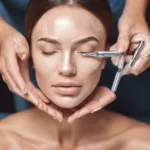24 November 2023
Discover the Benefits, Risks, and Steps Involved in Dermaplaning
Dermaplaning, a popular skincare procedure, has gained attention for its ability to reveal brighter, smoother skin by gently removing the top layers of skin and unwanted hair. This article provides a comprehensive guide to dermaplaning, exploring its benefits, risks, and the steps involved in the procedure. Whether you’re looking to reduce the appearance of acne scars, exfoliate dull skin, or remove unwanted hair, understanding dermaplaning can help you make an informed decision about this minimally invasive treatment.
What is Dermaplaning?
Dermaplaning involves the use of a handheld surgical device called a dermatome, which resembles a scalpel, to delicately shave off thin layers of skin and hair. This procedure can be performed either on specific problem areas or the entire face, depending on individual needs. Its primary purpose is to reduce the appearance of fine lines, wrinkles, and acne scars, leaving the skin looking rejuvenated and refreshed.
Dermaplaning vs. Dermabrasion vs. Microdermabrasion: What’s the Difference?
While dermaplaning, dermabrasion, and microdermabrasion are all methods of removing the top layers of skin, they differ in terms of tools used and the extent of skin removal. Microdermabrasion involves spraying microcrystals or using a diamond-tipped device to exfoliate the skin, followed by suctioning. Dermabrasion utilizes an electric rotating brush to remove the uppermost layers of skin, producing more dramatic results. Dermaplaning, on the other hand, uses a scalpel-like dermatome for deeper exfoliation, removing both skin and hair.
Benefits of Dermaplaning
Dermaplaning offers several potential benefits, including reducing the appearance of fine lines, minimizing acne scars and pitted skin, brightening dull and dry skin, removing peach fuzz (vellus hair), improving skin texture, treating sun-damaged skin, allowing for deeper absorption of skincare products, and preparing the skin for other treatments or surgical procedures. These benefits make dermaplaning an appealing option for individuals looking to improve the texture and appearance of their skin.
Who is Dermaplaning Right For?
Dermaplaning is suitable for almost anyone seeking to enhance their skin’s texture and appearance. Individuals with sun-damaged skin, signs of aging, or certain skin conditions like rosacea may find dermaplaning particularly beneficial. However, individuals with active acne breakouts, cold sores, skin rashes, burns, moles, or skin tags should avoid dermaplaning.
What Happens Before, During, and After Dermaplaning?
Before a dermaplaning session, a consultation with a dermatologist or aesthetician is essential to discuss goals and potential risks. Preparation for the procedure may include cleansing the face, removing makeup and skincare products, and avoiding certain medications. During the session, a numbing cream or anesthesia may be applied to minimize discomfort. The dermatome is then used to gently remove the top layers of skin. After the procedure, skincare products may be applied for deeper penetration. Visible results are often immediate, but temporary redness or sensitivity may occur, fading within a few months.
Risks of Dermaplaning
While dermaplaning is generally safe, there are potential risks to consider. These include scarring, nicks and cuts, fever blisters, skin irritation, and thickened skin. However, these risks are relatively rare, especially when the procedure is performed by a trained professional.
Do You Need Multiple Dermaplaning Procedures?
Dermaplaning results are not permanent, and multiple sessions may be necessary to maintain desired outcomes. Depending on the individual, dermaplaning sessions are typically recommended once a month to ensure ongoing improvements in skin texture and appearance.
Conclusion:
Dermaplaning offers a minimally invasive solution for individuals seeking to improve the texture and appearance of their skin. With its potential benefits of reducing fine lines, acne scars, and dullness, dermaplaning has become a popular choice. While there are risks involved, such as scarring and skin irritation, these are rare when performed by a trained professional. By understanding the procedure, its benefits, and risks, individuals can make an informed decision about whether dermaplaning is the right choice for their skincare needs.



